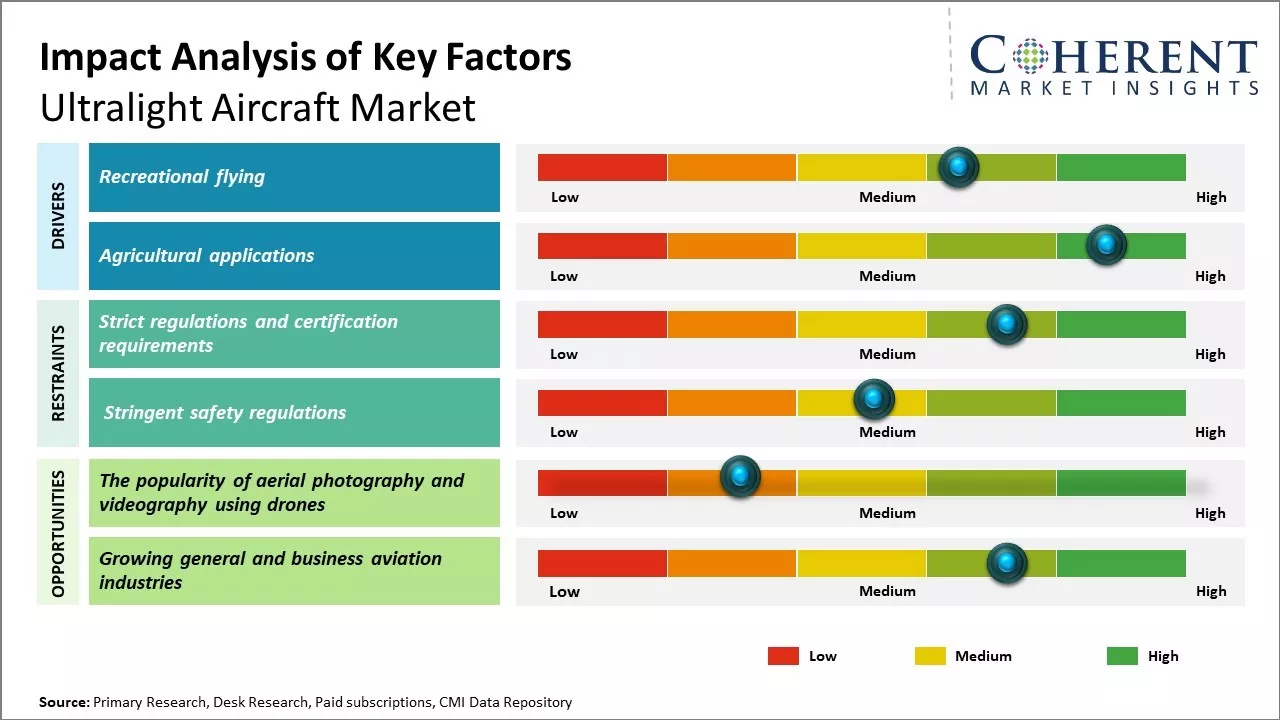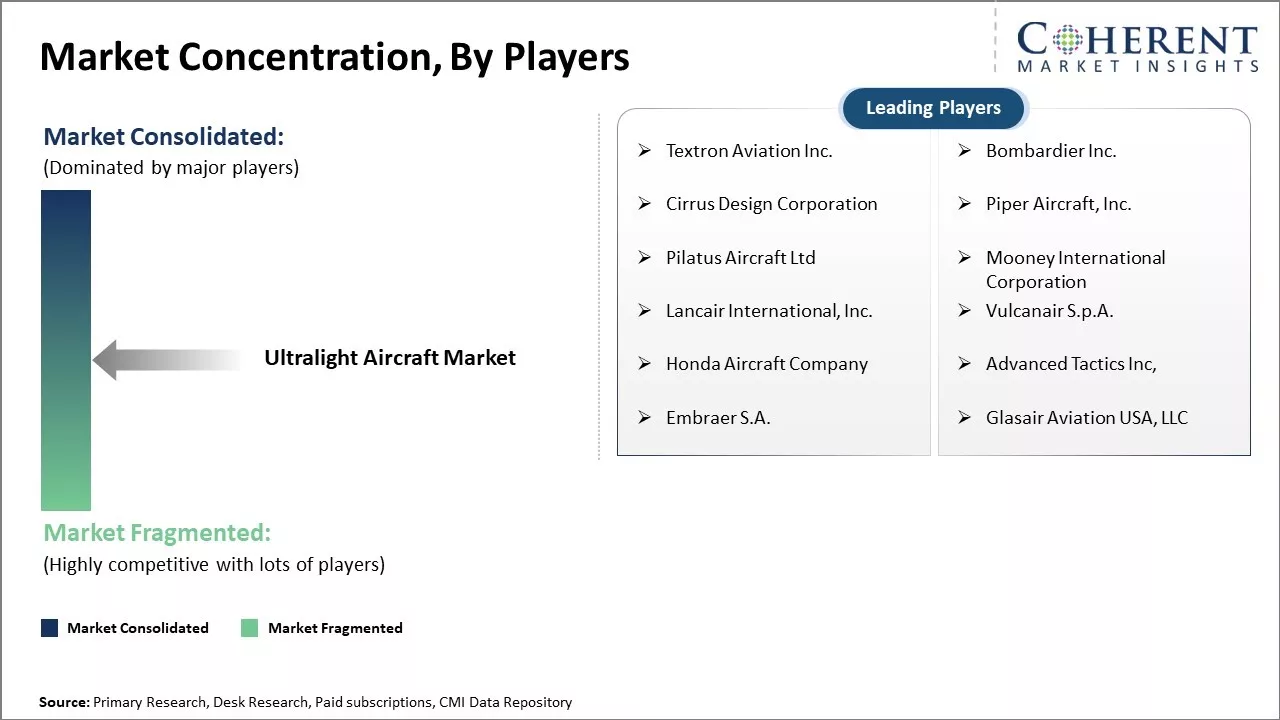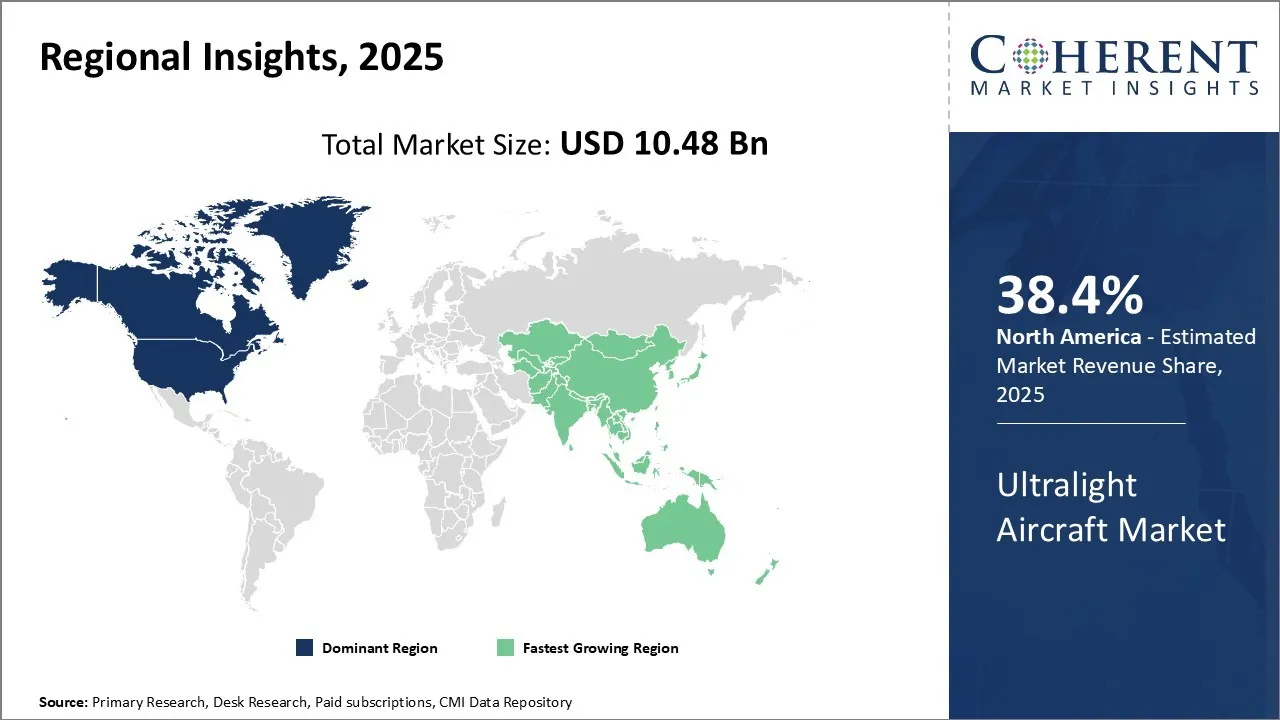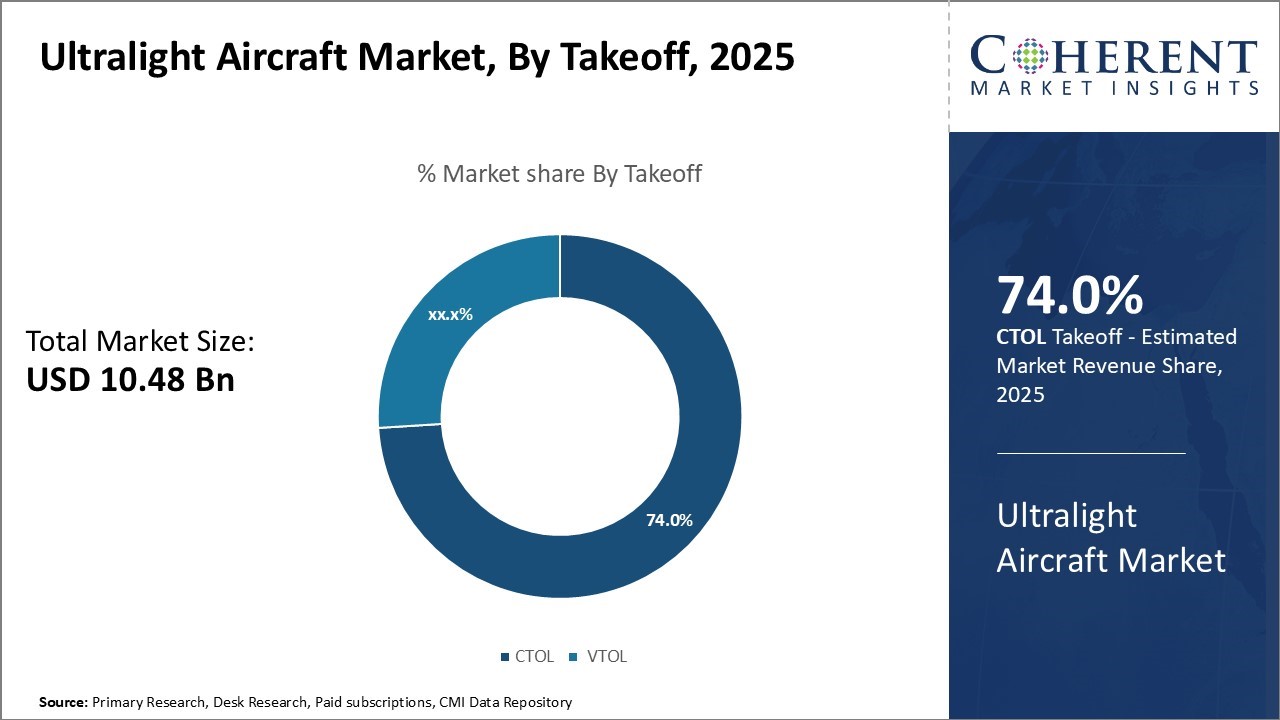Ultralight Aircraft Market Size and Trends Forecast – 2025 - 2032
The ultralight aircraft market is estimated to be valued at USD 10.48 Bn in 2025 and is expected to reach USD 20.17 Bn by 2032, exhibiting a compound annual growth rate (CAGR) of 9.8% from 2025 to 2032.

To learn more about this report, Download Free Sample
Key Takeaways of the Ultralight Aircraft Market
- By takeoff, the CTOL segment is estimated to contribute 74.0% share of the market in 2025.
- Based on technology, the manned aircraft segment is estimated to contribute the highest market share of 68.8% in 2025.
- By propulsion, the conventional propulsion segment is estimated to contribute the highest market share of 45.8% in 2025.
- North America remains the dominant player in the ultralight aircraft market and is estimated to account for 38.4%of the global market share in 2025.
Market Overview
Increasing disposable income and rising interest of people in leisure activities like adventure sports is driving the demand for ultralight aircraft for recreational activities. Moreover, ultralight aircraft are finding increasing usage for applications like agriculture, tourism, surveying, etc. which is further propelling the market growth.
However, stringent regulations around the operating license and certification of ultralight aircraft in some regions may slightly restrain the market growth during the forecast period.
Market Concentration and Competitive Landscape

To learn more about this report, Download Free Sample
Current Events and Its Impact
|
Current Events |
Description and its impact |
|
Regulatory and Certification Developments |
|
|
Geopolitical and Trade Dynamics |
|
Uncover macros and micros vetted on 75+ parameters: Get instant access to report
Market Trends
The Popularity of Aerial Photography and Videography Using Drones
Recreational and leisure flying is a growing activity among high-net-worth individuals globally. More countries are relaxing regulations on ultralight aircraft use could open new revenue streams. Technological advancements may help lower costs and improve performance. The popularity of aerial photography and videography using drones and tiny airplanes is expanding the usefulness of lightweight aircraft.
For instance, Pipistrel's Panthera introduces a four-seat, all-composite, high-performance design with multiple powertrain options, including a 145-kW hybrid-electric and a pure-electric variant. This showcases the firm's expansion from two-seat trainers into higher-capacity ultralights, bridging ultralight and general aviation sectors.
Strict Regulations and Certification Requirements
The ultralight aircraft market faces several challenges. Procedures often require frequent repeat visits, making long-term customer retention difficult. Many patients struggle with perceived risks from unlicensed or under-qualified practitioners. Strict regulations vary widely globally, necessitating navigating an intricate regulatory landscape. Additionally, market saturation in key territories pressures providers to continually develop new solutions and reach newer demographics.
Ultralight Aircraft Market Insights, by Takeoff: The Ease of Operations is Driving the Adoption of CTOL
In terms of takeoff, CTOL is expected to contribute the highest share of the market accounting for 74.0% in 2025 due to its simplicity and ease of operations. CTOL aircraft, or conventional takeoff and landing aircraft, takeoff and land on traditional airport runways unlike VTOL aircraft that can vertically takeoff and land.
The conventional runway infrastructure present at most general aviation airports makes it straightforward for CTOL ultra-light aircraft to operate without needing specialized facilities. Additionally, pilots find CTOL aircraft intuitive to fly since they handle and operate like traditional fixed-wing aircraft on the ground and in flight. Not requiring pilots to learn new control mechanisms or flight modes to manage vertical takeoffs and landings reduces training requirements.
Ultralight Aircraft Market Insights, by Technology: Technological Advancements Drive the Manned Aircraft Adoption
In terms of technology, the manned segment is expected to contribute the highest share of 68.8% in 2025 of the market owing to recent advancements that have enhanced their capabilities and reduced costs. Developments in avionics, composite materials, and engine technologies have improved the performance and efficiency of manned ultra-light aircraft.
More powerful yet economical engines further increase useful payloads and extended ranges. These innovations have made ultralight flying a more compelling personal transportation and recreational option. Meanwhile, the control and sensing requirements for unmanned aircraft to safely operate among other aircraft and systems without a pilot on board remain complex challenges.
Ultralight aircraft Market Insights, by Propulsion: Conventional Propulsion Remains Most Proven
In terms of propulsion, conventional propulsion is expected to contribute the highest share of the market owing to 45.8% in 2025 due to its proven reliability and lower costs compared to emerging electric and hybrid alternatives. Small gas or diesel reciprocating engines supplying thrust through traditional propellers or rotors remain the primary means of propulsion across most general and recreational ultralight aircraft.
Decades of widespread use have also revealed and addressed most issues, resulting in a high degree of dependability pilot demand. While electric and hybrid propulsion methods offer certain benefits like reduced emissions and noise, their battery and power system technologies need further advancement to achieve equivalent performance levels reliably at competitive prices. Addressing aircraft range, recharging logistics, and safety certification concerns could still take many more years.
Emerging Innovations in the Ultralight Aircraft Market
- Electric Propulsion Systems
- Application: Electric propulsion in ultralight aircraft involves using battery-powered electric motors instead of traditional combustion engines. This innovation is revolutionizing the segment by delivering zero-emission flight, lower noise, simplified mechanics, and reduced operational costs.
- For instance, Pipistrel's Velis Electro is the world’s first type-certified electric ultralight aircraft. It features dual battery packs, zero emissions, and extremely low noise levels (approximately 60 dB), making it ideal for flight training and urban areas.
- Lightweight Composite Materials
- Application: Lightweight composite materials—such as carbon fiber, glass-reinforced plastics (GRP), and Kevlar laminates—are critical to ultralight aircraft design. These materials offer high strength-to-weight ratios, corrosion resistance, and aerodynamic shaping flexibility, enabling aircraft to remain within strict weight limits without compromising structural integrity or performance.
- For instance, Aeroprakt’s A32 Vixxen utilizes a lightweight aluminum and composite hybrid airframe that maximizes aerodynamic efficiency while keeping empty weight low, meeting international ultralight standards.
Impacts of AI on the Ultralight Aircraft Market
Artificial intelligence continues to revolutionize the ultralight aircraft sector.
- The CTLS is one of the most popular light aircraft in the world due to its great overall performance, sporty handling, and class-leading safety features. The CTLS 2020 SE incorporates evolutionary changes that make it an even better airplane for the demands of professional flight schools, flying clubs as well as private owners. The standard airframe emergency parachute system (AEPS) is an important addition to the list of safety features on the CTLS 2020.
- The Alpha Trainer comes equipped with all the essential features expected for flight training, including a strong, durable undercarriage, and gentle flight characteristics. Suitable for both entry-level flight training and experienced aviators, the Alpha Trainer offers a quiet, relaxing cabin with easy access and is a comfortable learning environment for students. It is equipped with a ballistic parachute rescue system offering peace of mind.
Regional Insights

To learn more about this report, Download Free Sample
North America Ultralight Aircraft Market Analysis and Trends
North America has dominated the ultralight aircraft market for many years, accounting for an estimated 38.4% in 2025 due to its widespread adoption and strong presence of industry players in the region. The U.S. alone accounts for over 40.5% of the global fleet size.
For instance, in October 2024, Pivotal, the market leader in light electric Vertical Takeoff and Landing (eVTOL) aircraft, proudly announced that it has completed the delivery of 13 BlackFly aircraft to customers across the country. Pivotal’s prototype eVTOLs are currently being flown by private owners and the U.S. Air Force across numerous states, including California, Delaware, Kentucky, Massachusetts, Ohio, Oregon, Texas, and Washington, as part of the company’s Early Access Program (EAP).
Asia Pacific Ultralight Aircraft Market Analysis and Trends
One region that has emerged as the fastest growing is Asia Pacific. Countries like China, Australia, and India have shown significant momentum in the ultralight aircraft space in recent times. In China, events like increasing disposable income, evolving lifestyle preferences, and rising interest in adventure sports have translated into higher demand.
For instance, in April 2025, an article published in the Times of Central Asia stated that, Germany’s Flight Design GmbH, a leading manufacturer of ultralight aircraft with over 25 years of experience, is set to produce ultralight CT series aircraft in Kazakhstan. The project was announced at the Flight Design and Kazakh Invest press conference at the 30th AERO Friedrichshafen General Aviation Exhibition in Friedrichshafen, Germany, on April 19, 2024.
Ultralight Aircraft Market Outlook for Key Countries
U.S Ultralight Aircraft Market Analysis and Trends
The U.S. remains one of the largest markets for ultralight aircraft, driven by lenient regulatory frameworks under FAA Part 103, which allows individuals to fly ultralight vehicles without a pilot license or medical certificate. This ease of entry supports a growing community of recreational pilots and fosters innovation from companies like Pivotal (BlackFly) and Quicksilver Aircraft.
For instance, in June 2025, Textron Aviation announced that it is bringing a comprehensive lineup of its industry-leading products, to the 2025 Experimental Aircraft Association (EAA) AirVenture fly-in in Oshkosh, Wisconsin. The static display at Whitman Regional Airport will be the largest the company ever included at EAA, and the largest static display of any original equipment manufacturer (OEM) at this year’s show.
Germany Ultralight Aircraft Market Analysis and Trends
Germany is a leading European hub for ultralight aircraft development, anchored by manufacturers like Flight Design, AutoGyro, and TL-Ultralight. A deep-rooted aero-sport culture, coupled with EASA-supported certification pathways, makes Germany a mature and innovation-friendly market. The emphasis on composite materials, efficient engines, and advanced avionics positions Germany as both a major producer and consumer of ultralight aircraft, particularly in the sport and flight training segments.
India Ultralight Aircraft Market Analysis and Trends
India’s ultralight aircraft market is gaining traction due to rising demand for affordable flight training, aero tourism, and pilot licensing pathways. With the government promoting regional aviation and introducing UDAN-like initiatives for general aviation, ultralights are being increasingly seen as viable platforms for rural connectivity, agriculture monitoring, and aerial surveillance. Domestic manufacturers like X-Air and international imports are benefiting from relaxed import duties and DGCA's growing acceptance of experimental and light aircraft.
Australia Ultralight Aircraft Market Analysis and Trends
In Australia, ultralight aircraft are widely used not just for recreation, but also for practical applications in agriculture, land management, and remote area connectivity. The Recreational Aviation Australia (RAAus) regulatory body governs ultralight operations and supports pilot training and safety. With vast, sparsely populated regions, ultralights offer a cost-effective solution for aerial surveys, farm oversight, and even outback transport. Local companies and distributors are investing in durable, Short Takeoff and Landing (STOL)-capable ultralights suitable for rough terrain.
Pricing Analysis of the Ultralight Aircraft Market
The cost of acquiring an ultralight aircraft can vary significantly depending on whether it is purchased new, pre-owned, or built from a kit. Below is a general price breakdown to provide an overview of typical investment ranges:
- Cheapest Ultralight Aircraft to Buy: USD 5,000 to USD 15,000 (basic, used models)
- DIY & Homebuilt Ultralight Kits: USD 8,000 to USD 30,000
- Best Ultralight Aircraft for Beginners: USD 25,000 to USD 60,000+ (These are new and advanced models.)
- Ultralight Aircraft Price Comparison: Costs vary based on brand, condition, features, and materials used.
Market Report Scope
Ultralight Aircraft Market Report Coverage
| Report Coverage | Details | ||
|---|---|---|---|
| Base Year: | 2024 | Market Size in 2025: | USD 10.48 Bn |
| Historical Data for: | 2020 To 2024 | Forecast Period: | 2025 To 2032 |
| Forecast Period 2025 to 2032 CAGR: | 9.8% | 2032 Value Projection: | USD 20.17 Bn |
| Geographies covered: |
|
||
| Segments covered: |
|
||
| Companies covered: |
Textron Aviation Inc., Bombardier Inc., Cirrus Design Corporation, Piper Aircraft, Inc., Pilatus Aircraft Ltd, Mooney International Corporation, Lancair International, Inc., Vulcanair S.p.A., Honda Aircraft Company, Advanced Tactics Inc,, Embraer S.A., and Glasair Aviation USA, LLC. |
||
| Growth Drivers: |
|
||
| Restraints & Challenges: |
|
||
Uncover macros and micros vetted on 75+ parameters: Get instant access to report
Ultralight Aircraft Industry News
- In May 2025, Bombardier confirmed that the first production model of its Global 8000 aircraft completed its maiden flight. During the flight, the aircraft underwent a range of tests as part of its production flight-test protocol.
- In February 2025, Cirrus Aircraft Ltd unveiled the 2025 SR Series G7 Australis Edition. This is specifically designed for the Australian climate and the unique demands of remote flight operations, this model caters to the needs of local pilots with thoughtful enhancements.
- In February 2025, Piper Aircraft announced a new fleet agreement with Air India. The airline has placed an order for 31 Archer DX aircraft for delivery in 2025, with an option for 62 additional aircraft for 2026 and 2027. Deliveries are scheduled to begin in the first quarter of 2025.
Analyst View
- The ultralight aircraft market is entering a transformative growth phase, driven by the convergence of regulatory flexibility, technological innovation, and a rising demand for affordable personal aviation.
- Electric propulsion, AI-assisted stabilization, and lightweight composite materials are redefining design possibilities, allowing manufacturers to produce aircraft that are quieter, cleaner, and safer than ever before. Companies like Pipistrel, Pivotal, and Flight Design are leading this transition with certified electric models and semi-autonomous flight capabilities.
- Regionally, North America leads in recreational adoption and innovation, Europe continues to dominate high-performance sport ultralights. Asia Pacific is emerging as a volume-driven training and surveillance market, while Australia showcases strong use cases in agriculture and land access.
Market Segmentation
- Takeoff Insights (Revenue, USD Billion, 2020 - 2032)
- CTOL
- VTOL
- Technology Insights (Revenue, USD Billion, 2020 - 2032)
- Manned
- Unmanned
- Propulsion Insights (Revenue, USD Billion, 2020 - 2032)
- Conventional Propulsion
- Electric and Hybrid
- Application Insights (Revenue, USD Billion, 2020 - 2032)
- recreation
- defense
- commercial
- Regional Insights (Revenue, USD Billion, 2020 - 2032)
- North America
- U.S.
- Canada
- Latin America
- Brazil
- Argentina
- Mexico
- Rest of Latin America
- Europe
- Germany
- U.K.
- France
- Italy
- Russia
- Rest of Europe
- Asia Pacific
- China
- India
- Japan
- Australia
- South Korea
- ASEAN
- Rest of Asia Pacific
- Middle East & Africa
- GCC Countries
- South Africa
- Rest of Middle East & Africa
- Key Players
- Textron Aviation Inc.
- Bombardier Inc.
- Cirrus Design Corporation
- Piper Aircraft, Inc.
- Pilatus Aircraft Ltd
- Mooney International Corporation
- Lancair International, Inc.
- Vulcanair S.p.A.
- Honda Aircraft Company
- Advanced Tactics Inc
- Embraer S.A.
- Glasair Aviation USA, LLC
Sources
Primary Research Interviews
- Ultralight Aircraft Manufacturers (e.g., Flight Design, Aeroprakt, Pipistrel, Quicksilver, Rans Designs)
- Ultralight Pilots and Aviation Enthusiasts
- Flight Training Schools and Ultralight Flight Instructors
- Aviation Dealers and Distributors
- Regulatory Officials and Certification Bodies (FAA, EASA)
Magazines
- Light Aviation Magazine
- Ultralight Flying! Magazine
- Kitplanes
- Sport Aviation
- Pilot Magazine
- Aviation Week & Space Technology
- Others (e.g., Flying Magazine, AeroCrafter)
Journals
- Journal of Aircraft
- International Journal of Aviation, Aeronautics, and Aerospace
- Aerospace Science and Technology
- Transportation Research Record
- Others (e.g., Aviation, Space, and Environmental Medicine)
Newspapers
- The Wall Street Journal (Aviation Section)
- Financial Times (Aerospace & Defense)
- The Economic Times (Aviation & Transport)
- Aviation International News
- Forbes (Aerospace & Aviation)
- Others
Associations
- Experimental Aircraft Association (EAA)
- Light Aircraft Manufacturers Association (LAMA)
- Ultralight Aircraft Association (UAA)
- Aircraft Owners and Pilots Association (AOPA)
- Fédération Aéronautique Internationale (FAI)
- Others
Public Domain Sources
- Federal Aviation Administration (FAA) – regulations and certification data
- European Union Aviation Safety Agency (EASA)
- National Transportation Safety Board (NTSB) – safety reports
- Eurostat – aviation industry statistics
- United Nations Comtrade Database – aerospace trade data
- World Bank Open Data – transport infrastructure data
- Others
Proprietary Elements
- CMI Data Analytics Tool – Ultralight aircraft Market
- CMI Existing Repository of Information for the Last 8 Years
*Definition: The ultralight aircraft market consists of lightweight, 1- or 2-seat aircraft that can be flown without a pilot's license. These aircraft weigh less than 250 kg empty and have a maximum takeoff weight of less than 450 kg. They use simple engines, usually twin-cylinder, two-stroke motors of less than 100 hp, and have a fixed-tricycle or bicycle undercarriage. Ultralight aircraft are used mainly for sport and recreation rather than commercial applications.
Share
Share
About Author
Suraj Bhanudas Jagtap is a seasoned Senior Management Consultant with over 7 years of experience. He has served Fortune 500 companies and startups, helping clients with cross broader expansion and market entry access strategies. He has played significant role in offering strategic viewpoints and actionable insights for various client’s projects including demand analysis, and competitive analysis, identifying right channel partner among others.
Missing comfort of reading report in your local language? Find your preferred language :
Transform your Strategy with Exclusive Trending Reports :
Frequently Asked Questions
EXISTING CLIENTELE
Joining thousands of companies around the world committed to making the Excellent Business Solutions.
View All Our Clients

